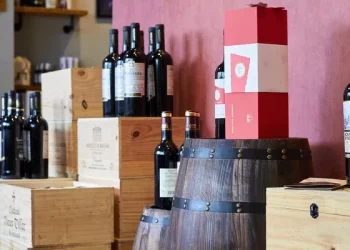Rosé wine is a popular wine variety that is appreciated for its refreshing taste, beautiful color, and versatility. Made by blending red and white wines or by fermenting red grapes with limited skin contact, rosé wine is a unique and delicious drink that can be enjoyed on its own or paired with a wide range of foods. In this article, we’ll take a closer look at how rosé wine is made.
Method 1: Blending
The blending method is a popular way of making rosé wine. It involves blending a small amount of red wine with white wine to produce the desired pink color and flavor. The process is fairly simple and involves the following steps:
Step 1: Harvest the grapes
The first step in making rosé wine is to harvest the grapes. Winemakers can use a wide variety of red and white grape varieties to create different blends and flavors.
Step 2: Press the grapes
After harvesting, the grapes are crushed and pressed to release their juices. The red grapes are usually kept separate from the white grapes to ensure that the juice remains colorless.
Step 3: Ferment the wine
The white wine is then fermented using a process similar to that used to make white wine. After the fermentation is complete, a small amount of red wine is added to the white wine to create the desired shade of pink. The blend is then aged for a short period of time to allow the flavors to develop.
Method 2: Maceration
The maceration method involves fermenting red grapes with limited skin contact. This allows the wine to pick up some of the red color and flavor, resulting in a light pink color. The process is as follows:
Step 1: Harvest the grapes
The first step in making rosé wine using the maceration method is to harvest the grapes. The red grapes are usually picked slightly earlier than they would be for a red wine, to ensure that they have a lower level of tannins and a lighter color.
Step 2: Crush the grapes
After harvesting, the grapes are crushed to release the juice. The juice is then left to macerate with the skins for a short period of time, usually a few hours or up to a few days.
Step 3: Ferment the wine
The juice is then fermented using a process similar to that used to make red wine. The fermentation process is stopped before all of the sugars have been converted to alcohol, resulting in a slightly sweet wine with a light pink color.
Step 4: Age the wine
The wine is then aged for a short period of time to allow the flavors to develop. This can be done in stainless steel tanks or in oak barrels, depending on the winemaker’s preference.
In conclusion, rosé wine can be made using two different methods: blending and maceration. The blending method involves mixing a small amount of red wine with white wine, while the maceration method involves fermenting red grapes with limited skin contact. Both methods produce delicious and refreshing wines that are perfect for warm summer days, or for pairing with a wide range of foods. Whether you prefer a light and fruity rosé or a more full-bodied version, there’s a rosé wine out there to suit every taste.












































